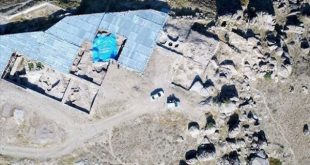 Astronomers have detected titanium oxide in the atmosphere of the exoplanet WASP-19b, located in the constellation of Sails rotating around a yellow dwarf star WASP-19.
Astronomers have detected titanium oxide in the atmosphere of the exoplanet WASP-19b, located in the constellation of Sails rotating around a yellow dwarf star WASP-19.
Observations using camera and spectrograph FORS2 (tool complex telescopes Very Large Telescope) has allowed scientists from the European southern Observatory (ESO) to see the chemical composition of the exoplanet WASP-19b, and also provided valuable information about the temperature in its atmosphere.
WASP-19b is very hot and unusual hot Jupiter, a distance of about 1,000 light years from Earth. The exoplanet has roughly the same mass as Jupiter, but due to the very close proximity to the parent star, it completes one revolution around it in just 19 hours. That is why it is so hot: the temperature of its atmosphere is estimated at 2 000 degrees Celsius.
When WASP-19b is in front of the star, some of the last rays pass through the atmosphere of the planet, leaving “traces” in the light that eventually reaches the Ground. Astronomers have been studying these “footprints” using FORS2 and came to the conclusion that the atmosphere of the exoplanet contains — along with much common fog — titanium oxide, sodium and water. (Previously, in 2013, in the atmosphere of WASP-19b by means of a telescope “Hubble” found water vapor.)
Titanium oxide rare on Earth; it is known that it exists in the atmospheres of cool stars. In the atmospheres of hot planets such as WASP-19b, the titanium oxide absorbs heat. If enough of the substance in the atmosphere, it prevents as the exit and entrance of heat. This causes a temperature inversion — when the upper atmosphere temperature is higher than at the bottom. Ozone, for example, does the same in the Earth’s atmosphere, causing the inversion in the stratosphere.
The researchers collected the data for WASP-19b, comparing their observations with models of the atmosphere. So they managed to learn about the atmospheric composition of exoplanets, and their results can be used further to create improved models of the atmospheres of other extrasolar planets. Will probably help in the interpretation of future observations of planets potentially suitable for life.
© 2017 – 2019, paradox. All rights reserved.




